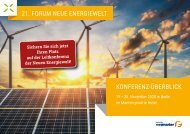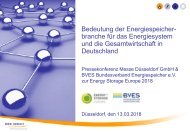Renewable Energy – Solutions for application in the communal energy infrastructure
This brochure contains a selection of successful renewable energy solutions suitable for a range of applications for local and national municipalities and economies. The main energy end-use sectors and the current state of the energy transition are briefly explained to provide readers with an understanding of the transformation of the greater energy system. The renewable energy technology options are explained, including their relevance and applications for municipalities. Finally, a selection of exemplary projects that have been successfully implemented in Europe, the Russian Federation and Central Asia, are included to demonstrate real applications and use-cases for renewable solutions. Renewable energies are cheap, clean and versatile.
This brochure contains a selection of successful renewable energy solutions suitable for a range of applications for local and national municipalities and economies. The main energy end-use sectors and the current state of the energy transition are briefly explained to provide readers with an understanding of the transformation of the greater energy system. The renewable energy technology options are explained, including their relevance and applications for municipalities. Finally, a selection of exemplary projects that have been successfully implemented in Europe, the Russian Federation and Central Asia, are included to demonstrate real applications and use-cases for renewable solutions. Renewable energies are cheap, clean and versatile.
You also want an ePaper? Increase the reach of your titles
YUMPU automatically turns print PDFs into web optimized ePapers that Google loves.
6 | INTRODUCTION TO THE “ENERGY TRANSITION”<br />
The <strong>Energy</strong> Transition<br />
S<strong>in</strong>ce <strong>in</strong>dustrialisation, <strong>the</strong> consumption of fossil fuels and raw materials has grown steadily. These still cover<br />
<strong>the</strong> majority of global <strong>energy</strong> demand. However, <strong>the</strong> share of renewable <strong>energy</strong> and <strong>energy</strong> efficiency <strong>in</strong> global<br />
<strong>in</strong>vestments <strong>in</strong> <strong>the</strong> <strong>energy</strong> sector is steadily <strong>in</strong>creas<strong>in</strong>g and has rema<strong>in</strong>ed more stable than <strong>in</strong>vestments <strong>in</strong><br />
conventional <strong>energy</strong>, even dur<strong>in</strong>g <strong>the</strong> Corona crisis. The transition from conventional <strong>energy</strong> sources to renewable<br />
and susta<strong>in</strong>able <strong>for</strong>ms of <strong>energy</strong> is occurr<strong>in</strong>g across all sectors, on a global scale.<br />
Electricity<br />
In 2018, <strong>the</strong> EU member states obta<strong>in</strong>ed around 32 per<br />
cent of <strong>the</strong>ir electricity from renewable sources. Climate<br />
protection targets and government fund<strong>in</strong>g are only one<br />
reason <strong>for</strong> this. The o<strong>the</strong>r is tangible economic benefits.<br />
The cost of w<strong>in</strong>d and solar <strong>energy</strong> has fallen so rapidly<br />
over <strong>the</strong> last twenty years that <strong>in</strong> many cases, <strong>the</strong>y<br />
are cheaper than fossil <strong>energy</strong> <strong>for</strong>ms. At <strong>the</strong> turn of<br />
<strong>the</strong> millennium, <strong>the</strong> generation of one kilowatt hour of<br />
solar electricity <strong>in</strong> Germany cost around 50 cents; today<br />
it is about a tenth of that.<br />
An <strong>in</strong>creas<strong>in</strong>g number of companies are conclud<strong>in</strong>g direct<br />
electricity supply contracts with solar system operators<br />
<strong>–</strong> without government subsidies. W<strong>in</strong>d power generation<br />
is also grow<strong>in</strong>g immensely. In 1997, global w<strong>in</strong>d power<br />
capacity was 7.5 gigawatts; <strong>in</strong> 2018, it was 564 gigawatts.<br />
Onshore w<strong>in</strong>d farms, <strong>in</strong> particular, are among <strong>the</strong> cheapest<br />
<strong>for</strong>ms of electricity generation today. Offshore w<strong>in</strong>d<br />
(w<strong>in</strong>d farms at sea) is somewhat more expensive because<br />
of <strong>the</strong> special conditions and requirements, but delivers<br />
<strong>energy</strong> with particular consistency.<br />
The fluctuat<strong>in</strong>g renewable <strong>energy</strong> sources (w<strong>in</strong>d and<br />
solar) are supplemented by controllable <strong>for</strong>ms of renewable<br />
<strong>energy</strong> <strong>–</strong> such as bio<strong>energy</strong> and hydropower,<br />
and by modern <strong>energy</strong> storage systems. Today, it is<br />
ma<strong>in</strong>ly batteries, but <strong>in</strong> <strong>the</strong> future it will <strong>in</strong>creas<strong>in</strong>gly<br />
be renewable <strong>energy</strong> carriers such as hydrogen.<br />
Ano<strong>the</strong>r positive effect of <strong>the</strong> <strong>Energy</strong> Transition is <strong>the</strong><br />
high level of regional added value. Instead of simply import<strong>in</strong>g<br />
fossil raw materials, <strong>in</strong>vestments flow <strong>in</strong>to local<br />
economies. In Germany alone, several hundred thousand<br />
jobs have been created <strong>in</strong> <strong>the</strong> green power sector.<br />
Build<strong>in</strong>g<br />
Much rema<strong>in</strong>s to be done <strong>in</strong> <strong>the</strong> build<strong>in</strong>g sector, which<br />
accounts <strong>for</strong> about 40% of <strong>the</strong> EU’s <strong>energy</strong> demand.<br />
Depend<strong>in</strong>g on <strong>the</strong> climate zone, this <strong>in</strong>cludes, above all,<br />
a considerable amount of <strong>energy</strong> <strong>for</strong> heat<strong>in</strong>g or cool<strong>in</strong>g.<br />
In 2018, <strong>the</strong> EU decided (<strong>in</strong> <strong>the</strong> “<strong>energy</strong> per<strong>for</strong>mance<br />
of build<strong>in</strong>gs directive”) that all member states must<br />
def<strong>in</strong>e a standard <strong>for</strong> new build<strong>in</strong>gs from 2020 that sets<br />
<strong>the</strong> <strong>energy</strong> requirement at almost zero. In technical<br />
terms, it has already been possible <strong>for</strong> years <strong>for</strong> build<strong>in</strong>gs<br />
to generate more <strong>energy</strong> than <strong>the</strong>y consume. The<br />
“Solar Settlement at Schlierberg” <strong>in</strong> Freiburg (Germany),<br />
<strong>the</strong> residential tower “Elithis Danube” <strong>in</strong> Strasbourg<br />
(France), <strong>the</strong> supermarket of <strong>the</strong> Migros cha<strong>in</strong><br />
<strong>in</strong> Zuzwil (Switzerland) and Solar-5 <strong>in</strong> Vladivostok are<br />
just a few of many examples. Member states must also<br />
present a plan <strong>for</strong> <strong>the</strong> reno vation of exist<strong>in</strong>g build<strong>in</strong>gs,<br />
as demanded by <strong>the</strong> EU.<br />
In order <strong>for</strong> <strong>the</strong> <strong>energy</strong> transition <strong>in</strong> <strong>the</strong> build<strong>in</strong>g sector<br />
to succeed, <strong>energy</strong> demand must be m<strong>in</strong>imised through<br />
measures such as efficiency standards, highly effective<br />
<strong>in</strong>sulation, and o<strong>the</strong>rs. At <strong>the</strong> same time, <strong>the</strong> demand<br />
must be met with renewable sources where possible.<br />
This can be done, <strong>for</strong> example, with a heat pump<br />
powered by electricity from a green electricity provider,<br />
or by generat<strong>in</strong>g heat or electricity with a solar system<br />
directly on <strong>the</strong> build<strong>in</strong>g. With good plann<strong>in</strong>g and<br />
a long-term time horizon, highly efficient houses save<br />
<strong>the</strong>ir occupants a lot of money.








